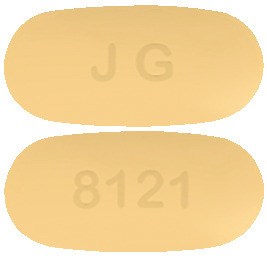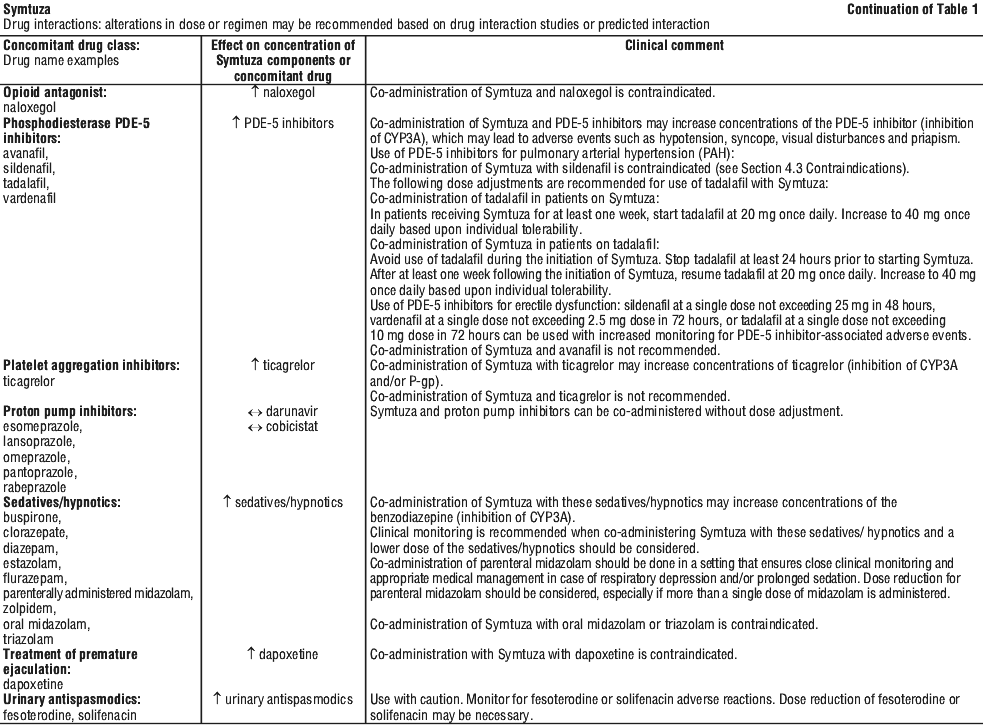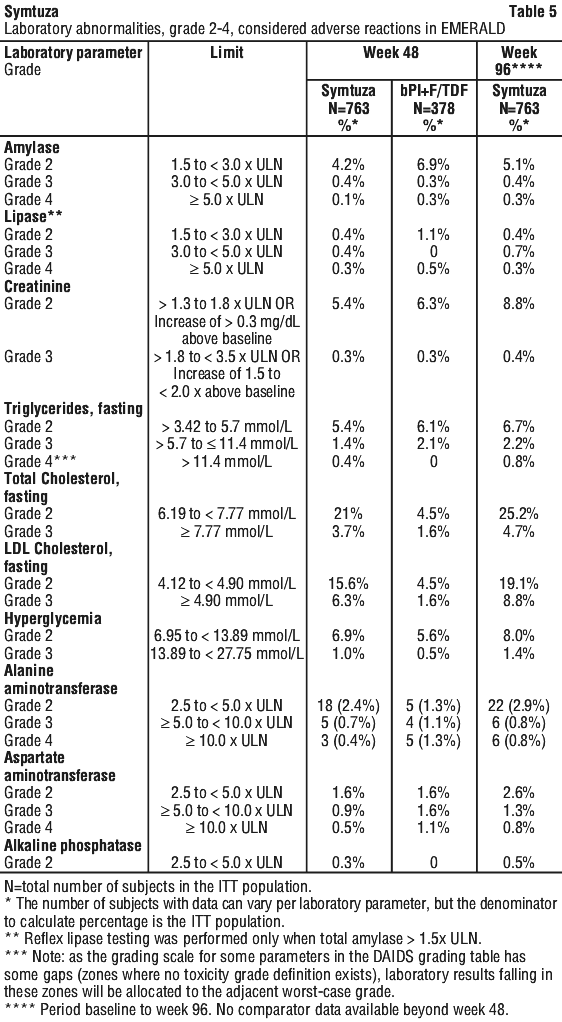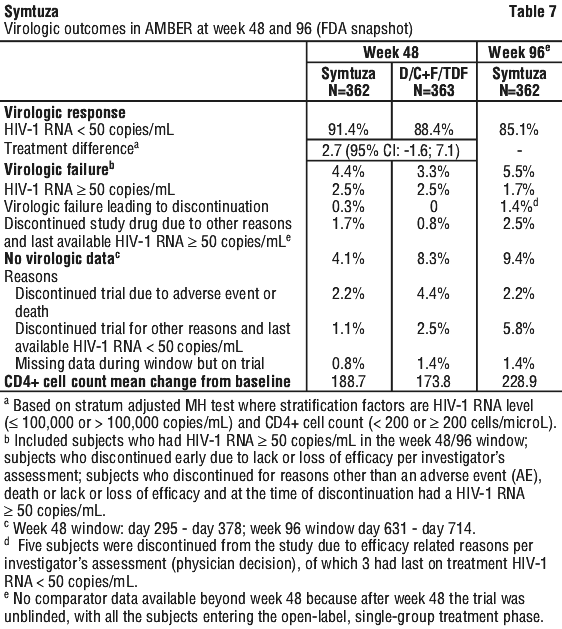What is in this leaflet
Read all of this leaflet carefully before you start taking this medicine.
This leaflet answers some common questions about SYMTUZA tablets. It does not contain all the available information. It does not take the place of talking to your doctor or pharmacist.
All medicines have risks and benefits. Your doctor has weighed the risks of you being given SYMTUZA against the benefits this medicine is expected to have for you.
If you have any concerns about being given SYMTUZA ask your doctor.
Keep this leaflet while you are taking SYMTUZA. You may need to read it again.
What SYMTUZA is used for
SYMTUZA is a single tablet regiment used to treat adults and adolescents 12 years of age and older who weigh at least 40 kg, who are infected by HIV (Human Immunodeficiency Virus).
SYMTUZA contains four active ingredients which work in combination for the treatment of HIV. These active ingredients are darunavir, cobicistat, emtricitabine and tenofovir alafenamide.
Darunavir, emtricitabine and tenofovir alafenamide are called antiretroviral medicines. Darunavir is medicine known as a protease inhibitor. Emtricitabine is a medicine known as a nucleoside reverse transcriptase inhibitor. Tenofovir alafenamide is a medicine known as a nucleotide reverse transcriptase inhibitor. Each of these three active ingredients work to reduce the amount of HIV in your body.
Cobicistat is a type of medicine called a pharmacokinetic enhancer (or "booster"). Cobicistat helps to increase the levels of darunavir in your body.
Reducing the amount of HIV in your blood improves your immune system and reduces the risk of developing illnesses as a result of HIV infection.
Ask your doctor if you have any questions about why SYMTUZA has been prescribed for you.
This medicine is available only with a doctor's prescription.
Before you take SYMTUZA
When you must not use it:
Do not take SYMTUZA:
- if you are allergic (hypersensitive) to darunavir, cobicistat, emtricitabine, tenofovir alafenamide or any of the other ingredients of SYMTUZA listed at the end of this document. Symptoms of an allergic reaction may include rash, itching or hives on the skin, shortness of breath, wheezing or difficulty breathing, swelling of the face, lips, tongue or other parts of the body.
Do not take SYMTUZA:
- if the packaging is torn or shows signs of tampering.
- if the expiry date (month and year) printed on the pack has passed. If you take SYMTUZA after the expiry date it may not work.
SYMTUZA should not be given to children younger than 12 years of age or weighing less than 40 kg.
Do not combine SYMTUZA with any of the following medicines:
- alfuzosin (to treat an enlarged prostate)
- astemizole or terfenadine (to treat allergy symptoms)
- amiodarone, bepridil, disopyramide, dronedarone, flecainide, systemic lidocaine, mexiletine, propafenone, quinidine (to treat irregular heartbeats)
- ivabradine or ranolazine (to treat heart disease)
- apixaban (used to reduce blood clotting)
- cisapride (to treat some stomach conditions)
- colchicine (to treat gout) if you have renal/hepatic impairment
- lovastatin, simvastatin or lomitapide (to lower cholesterol levels)
- lurasidone or pimozide (to treat psychiatric conditions)
- midazolam or triazolam (to treat trouble with sleeping and/or anxiety)
- carbamazepine, phenobarbital, phenytoin (medicines to prevent seizures)
- ergot alkaloids i.e. dihydroergotamine, ergonovine, ergotamine, methylergonovine (to treat migraine and headaches)
- sildenafil (to treat pulmonary arterial hypertension)
- rifampin (to treat some infections such as tuberculosis)
- elbasvir/grazoprevir (to treat hepatitis C)
- products that contain St John's wort (Hypericum perforatum) which is a herbal supplement used for depression and anxiety
- naloxegol (to treat constipation caused by taking opioids)
- dapoxetine (to treat premature ejaculation)
If you are taking any of these, ask your doctor about switching to another medicine.
Serious problems can happen if you take any of the medicines listed above with SYMTUZA.
In addition, you should also not take SYMTUZA with medicines that contain tenofovir disoproxil fumarate, lamivudine, or adefovir dipivoxil, or any anti-HIV medicines that have to be taken with ritonavir or cobicistat boosters.
This is not a complete list of medicines. Therefore, tell your doctor about all medicines you take.
There are other medicines that you need to be careful of when taking SYMTUZA (see Taking other medicines).
Before you start to use it:
Take special care with SYMTUZA:
SYMTUZA is not a cure for HIV infection.
SYMTUZA does not reduce the risk of passing HIV to others through sexual contact or blood. Therefore, you must continue to use appropriate precautions to prevent passing HIV on to others.
People taking SYMTUZA can still develop infections or other illnesses associated with HIV. You should continue to keep in regular contact with your doctor and to monitor your health while taking SYMTUZA.
Tell your doctor if you have or have had any medical conditions, especially the following:
- Problems with your liver, including hepatitis B and C.
Your doctor may need to evaluate how severe your liver disease is before deciding if you can take SYMTUZA. If you have hepatitis B, liver problems may become worse after you stop taking SYMTUZA. It is important not to stop taking SYMTUZA without talking to your doctor first. - Diabetes.
SYMTUZA, like some other anti-HIV medicines, might increase sugar levels in the blood. - Problems with your kidney.
Your doctor should do blood and urine test before starting and during treatment with SYMTUZA. Your doctor may tell you to stop taking SYMTUZA if you develop new or worse kidney problems. - Are allergic to foods, dyes, preservatives, sulfa medicines (sulphonamides) or any other medicines.
Tell your doctor immediately if you are pregnant or breastfeeding, or intend to become pregnant or breastfeed.
Do not take SYMTUZA if you are pregnant or breastfeeding. It is recommended that HIV infected women should not breastfeed their infants because of the possibility of your baby becoming infected with HIV through your breast milk and because of the unknown effects of the medicine on your baby. If you are a woman who has or will have a baby, talk with your doctor about the best way to feed your baby.
If you have not told your doctor about any of the above, tell them before you start treatment with SYMTUZA.
Taking other medicines:
Some medicines may affect the levels of SYMTUZA or SYMTUZA may affect the level of other medicines in the body when they are taken at the same time as SYMTUZA. Your doctor might want to do additional blood tests.
For this reason, tell your doctor about all medicines you take, including medicines you can buy without a prescription from a pharmacy, supermarket or health food shop.
Know the medicines you take. Keep a list of medicines and show it to your doctor and pharmacist when you get a new medicine. Your doctor and your pharmacist can tell you if you can take these medicines with SYMTUZA.
- Tell your doctor if you are taking any of the following: alfuzosin, amiodarone, apixaban, astemizole, bepridil, carbamazepine, cisapride, colchicine, dapoxetine, disopyramide, dronedarone, elbasvir/grazoprevir, ergot alkaloids (dihydroergotamine, ergonovine, ergotamine, methylergonovine), flecainide, ivabradine, lidocaine (systemic), lomitapide, lovastatin, lurasidone, mexiletine, midazolam, naloxegol, phenobarbital, phenytoin, pimozide, propafenone, quinidine, ranolazine, rifampin, sildenafil, simvastatin, products that contain St John's wort (Hypericum perforatum), terfenadine or triazolam. You must not take these medicines while taking SYMTUZA.
- If you take SYMTUZA with some other medicines, the effects of SYMTUZA or other medicines might be influenced. The dosage of some medicines may need to be changed. Some combinations are not recommended. Tell your doctor if you take any of the following:
- oestrogen-based hormonal contraceptives. SYMTUZA might reduce the effectiveness of hormonal contraceptives and/or increase their side effects. Therefore, alternative methods of non-hormonal contraception are recommended. If you take a contraceptive containing drospirenone your potassium levels might become elevated.
- medicines for heart disease (amlodipine, diltiazem, felodipine, nifedipine, nicardipine, tadalafil, verapamil).
- medicines to treat certain heart disorders (digoxin, carvedilol, metoprolol, timolol, bosentan)
- medicines used to reduce clotting of the blood (dabigatran etexilate, edoxaban, rivaroxaban, warfarin) or to prevent blood clots (ticagrelor, clopidogrel).
- medicines to lower cholesterol levels (atorvastatin, pitavastatin, pravastatin, rosuvastatin).
- medicines for your immune system (cyclosporin, everolimus, tacrolimus, sirolimus). Your doctor might want to do some additional tests.
- medicines to control asthma (budesonide, fluticasone, salmeterol).
- corticosteroids (prednisone, dexamethasone, betamethasone, mometasone, triamcinolone)
- medicines to treat cancer (dasatinib, everolimus, irinotecan, nilotinib, vinblastine, vincristine)
- medicines to treat pain (fentanyl, oxycodone, tramadol)
- medicines to treat narcotic dependence (buprenorphine/naloxone, methadone)
- medicines to treat malaria (artemether/lumefantrine)
- medicines to treat hepatitis C (boceprevir, glecaprevir/pibrentasvir)
- medicines to treat urinary disorders (fesoterodine, solifenacin)
- medicines to treat nausea and vomiting (domperidone)
- medicines to treat fungal infections (clotrimazole, fluconazole, isavuconazole, itraconazole, ketoconazole, posaconazole, voriconazole)
- medicines to treat some infections such as tuberculosis (rifabutin, rifapentine)
- medicines against bacterial infections (clarithromycin, erythromycin and telithromycin)
- medicines to treat gout (colchicine). If you have renal/hepatic impairment, do not take colchicine with SYMTUZA.
- medicines for erectile dysfunction (avanafil, vardenafil, sildenafil, tadalafil)
- medicines to treat depression and anxiety (amitriptyline, desipramine, imipramine, nortriptyline, paroxetine, sertraline, trazodone)
- sedatives (buspirone, clorazepate, diazepam, estazolam, flurazepam, zolpidem)
- medicines to treat psychiatric conditions (perphenazine, quetiapine, risperidone, thioridazine)
- medicines to prevent seizures (oxcarbazepine, clonazepam)
- medicines to treat excessive sleepiness (armodafinil, modafinil)
This is not a complete list of medicines. Therefore, tell your doctor about all medicines you take.
Taking SYMTUZA
Always use SYMTUZA exactly as your doctor has told you. You must check with your doctor if you are not sure.
Make sure that you always have enough SYMTUZA available so that you don't run out. For example, in case you cannot return home, need to travel or stay in a hospital. This is very important because the amount of virus may start to increase if the medicine is stopped for even a short time.
How much SYMTUZA to take:
The usual dose of SYMTUZA is one tablet orally, once daily with food.
You must take SYMTUZA every day and always with food. SYMTUZA cannot work properly without food. You must eat a meal or a snack within 30 minutes prior to taking your SYMTUZA. The type of food is not important.
Even if you feel better, do not stop taking SYMTUZA without talking to your doctor.
Instructions:
- Take SYMTUZA with food.
- Swallow the tablets with a drink such as water, milk, or any other nutritional drink.
- Take SYMTUZA at approximately the same time each day.
- If you are unable to swallow the whole tablet, tell your doctor. SYMTUZA may be split into two pieces using a tablet-cutter, and the entire dose should be taken with food immediately after splitting. Your doctor will determine whether SYMTUZA or its individual components are right for you.
Removing the child resistant cap
The plastic bottle comes with a child resistant cap and should be opened as follows:
- Push the plastic screw cap down while turning it counter clockwise.
- Remove the unscrewed cap.

What do I do if I forget to take SYMTUZA?
If you forget to take SYMTUZA
If you notice within 12 hours, you must take the tablets immediately. Always take with food. If you notice after 12 hours, then skip the intake and take the next doses as usual. Do not take a double dose to make up for a forgotten dose.
What do I do if I take too much? (overdose):
If you think you or anybody else has taken too much SYMTUZA, contact your doctor, pharmacist or the Poisons Information Centre who will advise you what to do.
You can contact the Poisons Information Centre by dialling:
- Australia: 13 11 26
Or go to the accident and emergency department at your nearest hospital. Do this even if there are no signs of discomfort or poisoning. This may need urgent medical attention.
While you are taking SYMTUZA
Things you must do:
Do not stop taking SYMTUZA without talking to your doctor first.
If you have both HIV infection and hepatitis B, it is very important not to stop taking SYMTUZA without talking to your doctor first. You may require blood tests for several months after stopping SYMTUZA treatment. In some patients with advanced liver disease or cirrhosis, stopping SYMTUZA treatment may lead to worsening of hepatitis, which may be life-threatening.
Tell your doctor if you have any medical conditions, especially the following:
- Symptoms of infection.
Tell your doctor immediately if you notice any symptoms of infection. In some patients with advanced HIV infection, signs and symptoms of inflammation from previous infections may occur soon after anti-HIV treatment is started. It is believed that these symptoms are due to an improvement in the body's immune response, enabling the body to fight infections that may have been present with no obvious symptoms.
HIV therapy may increase your sense of well being. Even when you feel better, do not stop taking SYMTUZA. Talk to your doctor first.
Be sure to keep all your doctor's appointments so your progress can be checked. Your doctor will want to do some blood, urine and other tests from time to time to check on your progress.
Be sure to follow up your doctor's instructions about other medicines you should take, and other things you should do.
Ask your doctor or pharmacist if you have any questions.
Tell any other doctors and pharmacists who are treating you that you are taking SYMTUZA. If you are undergoing anaesthesia, tell your anaesthetist that you are taking SYMTUZA.
If you are about to be started on any new medicines, tell your doctor or pharmacist that you are taking SYMTUZA.
If you become pregnant while taking SYMTUZA, tell your doctor immediately. You must not take SYMTUZA if you are pregnant.
If you have any further questions on the use of this product, ask your doctor.
Things you must not do:
- Do not breastfeed. See "Before you start to use it".
- Avoid doing things that can spread HIV infection since SYMTUZA does not stop you from passing the HIV infection to others:
- Do not share needles or other injection equipment.
- Do not share personal items that can have blood or body fluids on them, like toothbrushes or razor blades.
- Do not have any kind of sex without protection. Always practise safer sex by using a latex or polyurethane condom or other barrier to reduce the chance of passing the infection through semen, vaginal secretions, or blood. - Do not take SYMTUZA if the packaging is torn or shows signs of tampering.
Things to be careful of
Driving and using machines
Do not operate machines or drive if you feel dizzy after taking SYMTUZA.
Side Effects
Like all medicines, SYMTUZA can have side effects. Some of these effects may be serious.
Tell your doctor or pharmacist if you do not feel well while you are being treated with SYMTUZA.
When treating HIV infection, it is not always easy to identify what side effects are caused by SYMTUZA, which are caused by other medicines you are taking, or which are caused by the HIV infection itself.
The most common side effects are:
- headache
- abdominal pain, diarrhoea
- rash (see information below)
- fatigue
SYMTUZA may change some values of your blood chemistry. These can be seen in the results of blood tests. Your doctor will explain these to you.
Liver problems that may occasionally be severe have been reported. Your doctor should do blood tests prior to initiating SYMTUZA. If you have chronic hepatitis B or C infection, your doctor should check your blood tests more often because you have an increased chance of developing liver problems. Talk to your doctor about the signs and symptoms of liver problems. These may include yellowing of your skin or whites of your eyes, dark (tea coloured) urine, pale coloured stools (bowel movements), nausea, vomiting, loss of appetite, or pain, aching, or sensitivity on your right side below your ribs.
Skin rash has been reported in patients receiving SYMTUZA. Skin rash may affect more than 1 in 10 patients receiving SYMTUZA. Although most rashes are mild and disappear after a while when treatment is continued, a rash can occasionally be severe or potentially life-threatening. It is important to consult your doctor if you develop a rash. Your doctor will advise you how to deal with your symptoms or whether SYMTUZA must be stopped.
Tell your doctor if you experience the following side effects:
- upper abdominal pain that radiates into the back which may be due to inflammation of the pancreas
- increased blood fat levels
- diabetes
- symptoms of infection
Like other anti-HIV medicines, SYMTUZA may cause serious side effects, including:
- raised blood sugar and worsening of diabetes.
- immune reactivation syndrome. In some patients with advanced HIV infection (AIDS), signs and symptoms of inflammation from previous infections may occur soon after anti-HIV treatment is started, including SYMTUZA.
- muscle pain, tenderness or weakness. On rare occasions, these muscle disorders have been serious.
- new or worsening of kidney problems.
If you experience any of these side effects and they worry you, or if you notice any side effects not listed in this leaflet, please tell your doctor.
Tell your doctor if you notice signs or symptoms of infections, such as a fever or rashes. Some people with HIV who have had infections in the past may experience a return of symptoms soon after taking anti-HIV medicines.
If you think you are having an allergic reaction to SYMTUZA, tell your doctor immediately or go to Accident and Emergency at your nearest hospital.
Symptoms usually include some or all of the following:
- rash, itching or hives on the skin
- shortness of breath, wheezing or difficulty breathing
- swelling of the face, lips, tongue or other parts of the body.
Other side effects not listed above may also occur in some people.
Product Description
Storage
SYMTUZA tablets should be kept out of reach of children, in a location where the temperature stays below 30°C. Store in the original package with the dessicant inside the bottle in order to protect the tablets from moisture. Keep the bottle tightly closed.
What it looks like:
SYMTUZA 800/150/200/10 film-coated tablet: yellow to yellow-brownish capsule-shaped 2.2 x 1.1 cm tablet, debossed with “8121” on one side and “JG” on the opposite side.
Each plastic bottle contains 30 tablets.
Ingredients
Active ingredients:
- darunavir 800 mg (as darunavir ethanolate)
- cobicistat 150 mg (on silicon dioxide)
- emtricitabine 200 mg
- tenofovir alafenamide 10 mg (as tenofovir alafenamide fumarate)
Other ingredients:
- croscarmellose sodium
- magnesium stearate
- microcrystalline cellulose
- silicon dioxide
- OPADRY II complete film coating system 85F120020 YELLOW (ARTG PI No. 114529)
Sponsor
JANSSEN-CILAG Pty Ltd
1-5 Khartoum Rd
Macquarie Park NSW 2113
Australia
Telephone: 1800 226 334

Registration numbers
Registration number of SYMTUZA 800/150/200/10 film-coated tablets: AUST R 312623
This leaflet was prepared in 27 March 2023.
® SYMTUZA is a registered trademark of Janssen-Cilag Pty Ltd.
Published by MIMS May 2023





 Laboratory abnormalities (≥ Grade 2 severity), reported in AMBER and considered adverse reactions are shown in Table 3.
Laboratory abnormalities (≥ Grade 2 severity), reported in AMBER and considered adverse reactions are shown in Table 3.
 Laboratory abnormalities (≥ Grade 2 severity), reported in EMERALD and considered adverse reactions are shown in Table 5.
Laboratory abnormalities (≥ Grade 2 severity), reported in EMERALD and considered adverse reactions are shown in Table 5. The following additional adverse reactions have been observed in darunavir trials:
The following additional adverse reactions have been observed in darunavir trials:


 In the open-label study GS-US-292-0106, the efficacy, safety, and pharmacokinetics of emtricitabine and tenofovir alafenamide were evaluated in 50 HIV-1 infected, treatment-naïve adolescents receiving emtricitabine and tenofovir alafenamide (10 mg) together with elvitegravir and cobicistat as a fixed-dose combination tablet. Patients had a median age of 15 years (range: 12-17), and 56% were female, 12% were Asian, and 88% were Black. At baseline, median plasma HIV-1 RNA was 4.7 log10 copies/mL (range: 3.25-6.50), median CD4+ cell count was 456 cells/mm3 (range: 95-1110), and median CD4+ % was 23% (range: 7-45%). Overall, 22% had baseline plasma HIV-1 RNA > 100,000 copies/mL. At 48 weeks, 92% (46/50) achieved HIV-1 RNA < 50 copies/mL (FDA Snapshot), similar to response rates in studies of treatment-naïve HIV-1 infected adults. The mean increase from baseline in CD4+ cell count at week 48 was 224 cells/mm3. No emergent resistance to elvitegravir/cobicistat/emtricitabine/tenofovir alafenamide was detected through week 48.
In the open-label study GS-US-292-0106, the efficacy, safety, and pharmacokinetics of emtricitabine and tenofovir alafenamide were evaluated in 50 HIV-1 infected, treatment-naïve adolescents receiving emtricitabine and tenofovir alafenamide (10 mg) together with elvitegravir and cobicistat as a fixed-dose combination tablet. Patients had a median age of 15 years (range: 12-17), and 56% were female, 12% were Asian, and 88% were Black. At baseline, median plasma HIV-1 RNA was 4.7 log10 copies/mL (range: 3.25-6.50), median CD4+ cell count was 456 cells/mm3 (range: 95-1110), and median CD4+ % was 23% (range: 7-45%). Overall, 22% had baseline plasma HIV-1 RNA > 100,000 copies/mL. At 48 weeks, 92% (46/50) achieved HIV-1 RNA < 50 copies/mL (FDA Snapshot), similar to response rates in studies of treatment-naïve HIV-1 infected adults. The mean increase from baseline in CD4+ cell count at week 48 was 224 cells/mm3. No emergent resistance to elvitegravir/cobicistat/emtricitabine/tenofovir alafenamide was detected through week 48.
 In women receiving darunavir/cobicistat 800/150 mg q.d. during the 2nd trimester of pregnancy, mean intra-individual values for total darunavir Cmax, AUC24h and Cmin were 49%, 56% and 92% lower, respectively, as compared with postpartum; during the 3rd trimester of pregnancy, total darunavir Cmax, AUC24h and Cmin values were 37%, 50% and 89% lower, respectively, as compared with postpartum.
In women receiving darunavir/cobicistat 800/150 mg q.d. during the 2nd trimester of pregnancy, mean intra-individual values for total darunavir Cmax, AUC24h and Cmin were 49%, 56% and 92% lower, respectively, as compared with postpartum; during the 3rd trimester of pregnancy, total darunavir Cmax, AUC24h and Cmin values were 37%, 50% and 89% lower, respectively, as compared with postpartum. It has an empirical formula of C27H37N3O7S and a molecular weight of 547.66.
It has an empirical formula of C27H37N3O7S and a molecular weight of 547.66. It has an empirical formula of C40H53N7O5S2 and a molecular weight of 776.0.
It has an empirical formula of C40H53N7O5S2 and a molecular weight of 776.0. It has an empirical formula of C8H10FN3O3S and a molecular weight of 247.2.
It has an empirical formula of C8H10FN3O3S and a molecular weight of 247.2. It has an empirical formula of C21H29O5N6P.½(C4H4O4) and a molecular weight of 534.50.
It has an empirical formula of C21H29O5N6P.½(C4H4O4) and a molecular weight of 534.50.